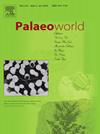华北板块南缘辛集地层(寒武系2)的风暴沉积和微量化石
IF 1.7
3区 地球科学
Q2 PALEONTOLOGY
引用次数: 0
摘要
华北板块南缘的辛集地层(寒武系 2)发育典型的硅质风暴沉积和丰富的微量化石。这些沉积的基本特征包括侵蚀面、滞后沉积、块状层理、驼峰状交叉层理、水平或波浪状层理等。研究区域的风暴沉积以驼峰状交叉层理的发育为主,根据不同沉积单元在剖面上的排列,可分为五种风暴沉积类型。从 I 到 V 这五种类型的风暴沉积显示了近端风暴沉积向远端风暴沉积的过渡、风暴强度的逐渐减弱以及与之相关的静止期的增长。痕量化石主要发育在风暴事件之间的砂岩-泥岩夹层中,包括 11 个化石属中的 14 个化石种:isp.、、、、、isp.、、、isp.、isp.、、、isp.、isp.、isp.、isp.。通过分析不同风暴沉积物的虫态指数(洞穴大小、虫态指数、虫态多样性和虫态差),可以看出从风暴沉积物 I 型到风暴沉积物 V 型,虫态指数呈上升趋势。结合风暴沉积与痕量化石之间的关系,可以推断风暴强度的不同会导致不同的定殖窗口,从而使保存下来的痕量化石的生态指数发生变化。根据风暴沉积和痕量化石的分布特征,探讨了风暴影响下痕量化石的保存形式。本文章由计算机程序翻译,如有差异,请以英文原文为准。
Storm deposits and trace fossils of Xinji Formation (Cambrian Series 2) in the southern margin of North China Plate
The Xinji Formation (Cambrian Series 2) in the southern margin of the North China Plate developed typical siliciclastic storm deposits and abundant trace fossils. These deposits are characterized by essential indicators, such as erosional surfaces, lag deposits, blocky beddings, hummocky cross stratifications, horizontal or wavy beddings. Storm deposits in the study area are dominated by the development of hummocky cross stratifications, which is categorized into five storm deposit types based on the arrangement of different sedimentary units in the profile. These five types of storm deposits from I to V show the transition from proximal storm deposits to distal storm deposits, the gradual weakening of storm intensity, and the associated growth of quiescent intervals. The trace fossils are mainly developed in the sandstone-mudstone interbeds between storm events and include 14 ichnospecies in 11 ichnogenera: Didymaulichnus isp., Gordia marina, Helminthopsis tenuis, Oldhamia radiata, Palaeophycus striatus, Palaeophycus tubularis, Phycodes isp., Planolites beverleyensis, Planolites montanus, Planolites punctatus, Skolithos isp., Taenidium isp., Torrowangea rosei, Treptichnus pedum. By analyzing the ichnological index (burrow size, BPBI, ichnodiversity and ichnodisparity) from different storm deposits, it can be seen that from storm deposit type I to storm deposit type V, the ichnological index shows an increasing trend. Combined with the relationship between storm deposits and trace fossils, it is inferred that differences in storm intensity result in different colonization windows, and thus variations in ichnological index of preserved trace fossils. Based on the characteristics of storm deposits and distribution of trace fossils, the preservation forms of trace fossils under storm influence are explored.
求助全文
通过发布文献求助,成功后即可免费获取论文全文。
去求助
来源期刊

Palaeoworld
PALEONTOLOGY-
CiteScore
4.00
自引率
5.90%
发文量
95
期刊介绍:
Palaeoworld is a peer-reviewed quarterly journal dedicated to the study of past life and its environment. We encourage submission of original manuscripts on all aspects of palaeontology and stratigraphy, comparisons of regional and global data in time and space, and results generated by interdisciplinary investigations in related fields. Some issues will be devoted entirely to a special theme whereas others will be composed of contributed articles. Palaeoworld is dedicated to serving a broad spectrum of geoscientists and palaeobiologists as well as serving as a resource for students in fields as diverse as palaeobiology, evolutionary biology, taxonomy and phylogeny, geobiology, historical geology, and palaeoenvironment.
Palaeoworld publishes original articles in the following areas:
•Phylogeny and taxonomic studies of all fossil groups
•Biostratigraphy, chemostratigraphy, chronostratigraphy
•Palaeoecology, palaeoenvironment and global changes throughout Earth history
•Tempo and mode of biological evolution
•Biological events in Earth history (e.g., extinctions, radiations)
•Ecosystem evolution
•Geobiology and molecular palaeobiology
•Palaeontological and stratigraphic methods
•Interdisciplinary studies focusing on fossils and strata
 求助内容:
求助内容: 应助结果提醒方式:
应助结果提醒方式:


